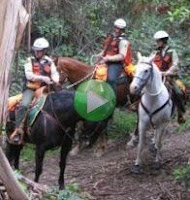 As I was wondering what I should explore this week, I got an email from Roberta asking about how to deal with a rearing horse. Great timing, Roberta!
As I was wondering what I should explore this week, I got an email from Roberta asking about how to deal with a rearing horse. Great timing, Roberta!Actually, timing has a lot to do with successful horse handling in all its forms. When you apply pressure – and just as important, when you take the pressure away – determines how clearly your message gets across to the horse.
Let’s start with the horse that rears when being led. I learned this from Clinton Anderson during the four years I hosted his tour and I had the occasion to use it when I started my filly, Sarah. By the way, when the horse rears the first time, it will probably catch you off guard. Get through that experience the safest way you can. Then, get yourself prepared and plan what you’re going to do next time.
To prepare, put on some leather gloves and put the horse in a longer-than-normal lead rope – at least 12’. Instead of avoiding the situation in which the horse reared, revisit it. When the horse rears, let the rope play out until you are safely out of reach of the horse’s hooves. Hold the rope as high as you can to make it more difficult to snag with his forelegs. Then just wait. No need to scold the horse or try to pull him back to the ground. Just keep moderate pressure on the lead rope. When the horse comes back to the ground, release the rope pressure instantly and reward the horse with kind words and a good rub. Then go right back to what you were doing when he reared. If he rears again, calmly repeat the process.
Understand why this works? The “bad” behavior doesn’t get the horse anything at all. It doesn’t get you to leave him alone and it doesn’t get the rope to go away. On top of that, it’s a lot of work! On the other hand, coming back to terra firma ends the exertion and gets a reward from you. You maintained a calm, businesslike attitude during the episode so you didn’t frighten the horse. If you are consistent with how you react to rearing, the behavior should all but disappear. I say, “all but disappear” because there are never any guarantees with training horses. We simply deal with the behavior that is presented to us at any given time.
Rearing while riding is a different issue and I’ll admit I have virtually no personal experience dealing with this. However, I do know from interviewing many experts that the worst thing you can do is what comes most naturally. We humans feel safest in a fetal position with arms and legs pulled in close to us. When a horse rears while you are riding, you may feel inclined to pull back on the reins and squeeze with your legs, closing up your body in an approximation of the fetal position. That can make matters quite a bit worse, even causing the horse to fall over backward or go into an all out flight mode.
When a horse rears while you’re riding him, move your hands forward and your legs back. Open up your body rather than closing it. If you need to grab the saddle horn or pommel, that’s just fine. The idea is for you to remain balanced on the horse instead of tumbling off and also to give the horse freedom to lower his head and come back to earth. Once the horse’s feet are back on the ground you have a choice to make. You can either reward him for ending his “bad” behavior or, if you feel he is about to rear again, you can disengage his hindquarters by pulling on one rein and asking him to cross one hind leg in front of the other. This is often called the one-rein stop. It’s not a punishment, but it does get the horse thinking about his feet and your ability to control them, thus reinforcing your role as leader and making it less likely that he will want to challenge you by rearing. Which course of action you take depends on the feel of the moment and your level of confidence … or lack thereof. If at all possible, you need to resume the activity where the rearing occurred and proceed as if nothing happened.
Rearing is most often an act of defiance that becomes a habit because the horse gets something he perceives as positive from the experience. Ironically, the act of rearing is its own punishment because of the effort it takes to perform. When given a choice, a horse will generally take the path of least effort. Many times, a good training solution is simply making that path clear.


